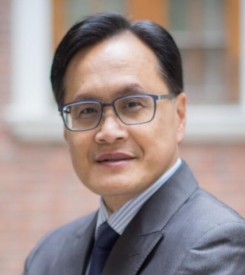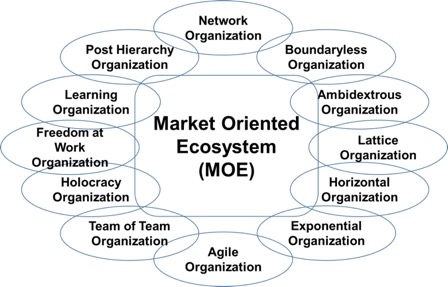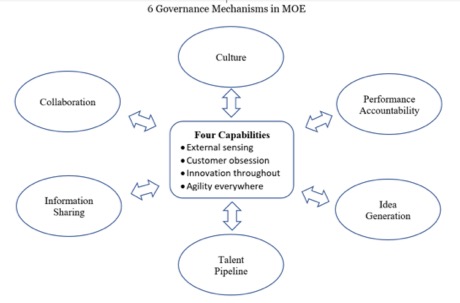„The emerging choices are around platforms“

Market-Oriented Ecosystems are about the organization itself
Arthur Yeung, Dave Ulrich, In your new book "Reinventing the Organization" you develop the idea of Market-Oriented Ecosystems (MOE). What is it about?
This book reinvents organization thinking to help leaders recognize new design principles of organization and implement management practices that help their organizations adapt to changing business conditions in ways that
- Deliver innovative products and services to customers;
- Create market value for investors;
- Increase employee sentiment and productivity;
- Provide value to a broader society or community interest
We followed three tracks to reinvent organization thinking. First, we synthesized and integrated a plethora of innovative organization ideas (holocracy, exponential, ameba, team of teams, boundaryless, network, platform, agile, ambidextrous, lattice, and so forth). Each of these organizational innovations offers unique insights on parts of what makes an effective organization in today’s changing world. We pulled these separate insights into an integrated framework that guides leaders as they reinvent their organization.
With MOE we wanted to capture a reinvention of the overall organization species, not just organization design.

Second, we identified some of the most innovative and successful organizations of our time from China (Alibaba, Tencent, Haier, Huawei), the US (Amazon, Facebook, Google) and Europe (Supercell) and were able to do deep dives into these organizations to explore how they are reinventing their organizations to win. Our goal is not merely to examine what they are doing as exemplary companies, but more importantly to study the logic and principles behind their practices. Operating in hyper dynamic environment, these iconic companies keep reinventing. It would not be a surprise that some of the companies we study will change, even by the time the book is published and beyond. But the principles of the new organization remain much the same and the practices (tools and actions) may be somewhat stable over time.
Our goal is not merely to examine what enterprises are doing as exemplary companies, but more importantly to study the logic and principles behind their practices.
Third, we drew on our personal experiences. For the last four decades we have observed, studied, and advised organizations. Arthur is a leading thinker about Chinese organizations and worked with over 300 Chinese entrepreneurs and CEOs through quarterly meetings since 2010. I have advised over half of the Fortune 200, and won numerous lifetime achievement awards. Together, we have published over 40 books on organization, talent, human resources, and leadership. We have been instrumental in defining and shaping concepts such as: organization capability, boundaryless organization, culture, transformation, learning organization, networks, platforms, leadership brand, leadership capital, business partner, paradox navigator, and strategic agility.
Rethinking how to build organizations
From these streams of work, we have defined the MOE to propose both the principles and practices that reinvent how to think about and build organizations. We hope these ideas will help any leader tasked to build stronger organizations and organization architects (in HR, organization development, or consulting) who shape and deliver this new organization form.
What differenciates MOE from other management concepts as self-organized network organizations, Holocracy, Adhocracy, FLEAT etc.?
We are clearly not the first to recognize the power of organization and to offer solutions that will anticipate customer demands, innovate thoughtfully, inspire employees, and respond quickly. Many have tried to re-define organization in a post-hierarchy world. Each organizational experiment offers components of a new model of organization.
To better move people around, some experiment with a lattice structure that enables and rewards moving sideways. To create better interconnection, some reframe an organization as a network. If we want to unlock greater speed, can the “ambidextrous” organization do that for us? If we want to engage others both inside and beyond our corporate borders, might the “boundaryless” organization be the way to go? Will the holocracy provide the miracle cure for the hierarchy’s excessive need for control, handing the organization over to self-management and self-organization by team? How about ameba organization or micro-firms that flip organizational hierarchy upside down? Will the exponential organization respond quickly enough to market changes?

Each of these ideas captures a “piece” of the MOE (market oriented ecosystem) puzzle. We wanted to capture a reinvention of the overall organization species, not just organization design. While we owe a great debt to the innovators and early adopters who have conducted these brave organizational experiments, they are piecemeal, not integrated, solutions. They innovate organization practices; but they do not reinvent the organization.
Agile organization, network organization, holocracy organization ... they all innovate organization practices; but they do not reinvent the organization.
We believe it is now time to offer you a holistic and integrated approach on how to reinvent your organization; one based on new principles and enacted through new practices. You don’t just want to run organizational experiments, but have real and sustainable impact.
It's not about experiments
Is MOE an anti-hierarchical concept? Are we talking about self-organization? Or can you manage MOEs in a classical way?
Our work focused on governance of the MOE as part of the overall emerging organizational species. Organizational governance used to mean exclusively, in a word, control. Oversight committees established rules and internal regulations at the top that often resulted in time consuming and often convoluted approvals processes as checks not only on potential malfeasance but also on what "not" to do.
In the MOE, governance is more about what "to do" so that the ecosystem moves rapidly to respond to market opportunities. MOE governance is about coordination of shared beliefs and priorities, generation of new ideas, fluid movement of talent, rapid sharing of knowledge, data, and insights, and collaboration of units throughout the entire ecosystem that supports success under today’s extreme conditions – not simply staying out of failure. Governance in a MOE is, as the saying goes, less about doing the right thing and more about doing things right by making the four key MOE capabilities of external sensing, customer obsession, innovation, and agility come to life.
Our research uncovered six key governance attributes that impact how these super-successful companies deliver on the four key capabilities.

Individuals, teams, network cells all collaborate
In MOEs, as I understood, people come together to form cross-functional teams to develop new offerings from ideation until go to market and beyond. Who decides which team is getting money and resources? The CEO, the business board …?
Teams come together to win in the marketplace. The customer generally sets criteria for how these teams come together as governed by collaboration processes. Collaboration deals with a rather simple challenge of making the whole more than the parts. This collaboration occurs with teams who combine individual skills into team performance as well as the network where individual cells or teams collaborate with each other to make the network better than any single cell. Instead of relying on command and control approach prevalent in traditional hierarchy, MOE uses market mechanism to facilitate win-win collaboration.
The Market-Oriented Ecosystem is less about what not to do but rather more about what to do.
With more independent teams, the complexitiy in the organization will increase. How will you foster the collaboration and the alignment between the units?
Traditionally, organization design choices have been about things like roles, responsibilities, processes, reporting relationships, positions, span of control, alignment, and so forth. These choices would lead to the organization model around hierarchy, holding company, multidivisional firm, and so forth.
In today’s rapidly changing world where strategic agility replaces strategic planning, the emerging choices are around platforms, cells, and alliances and how to design them to create and sustain ecosystem capabilities. This emerging MOE organizational form advances both the traditional multi divisional firm and the holding company. MOEs that can truly master the challenges of what the platform offers and to whom, and how the cells and strategic partners support and reinforce each other will truly have a competitive advantage that others can only wonder at.
MOE is part of platform economy
The MOEs we studied started fresh by making these new organizational choices. If you are a leader of a newer or start up firm, you can begin with a clean sheet to create the right platform, cells, and allies and integrated capabilities that anticipate and grasp market opportunities.
In today’s rapidly changing world where strategic agility replaces strategic planning, the emerging choices are around platforms, cells, and alliances and how to design them to create and sustain ecosystem capabilities.
How is the relation of running businesses and new initiatives? How do the two worlds cooperate?
This refers to the role of platform and cells as the organization design. The primary organizing principle for platforms is: Everything that can or should be shared is on the platform. The primary mission of platform is to offer shared resources and competences to support a set of self-driven, highly autonomous cells and business allies to win in the marketplace.
Each team will have embedded within it the functions or expertise that it needs for its own special purpose, such as product design, product development, operation, sales, and product marketing.
The platform empowers rather than controls. It is important for the platform to create the right structures and incentives to align with the needs and priorities of teams. Business/cell teams are customers for platform to serve and empower. In order to create synergy, a major feature of a highly successful platform is to set common standards so that tools, data, coding, and processes can be easily shared to facilitate the interconnections that the ecosystem needs. Since ecosystems are, by intention, highly dynamic, the platform needs to be as flexible as possible while also providing what is needed reliable enough for others to depend on.
The business teams are the business drivers for growth and profitability of the ecosystem. While the platform plays the vital roles of strong back-end support and synergy sharing, the teams most directly create the value. Like special elite forces in the field, they are self-contained units to capture and ride on environmental opportunities that shape new markets. From the point of view of the ecosystem, individual teams should focus on specific product niches and fit together like jigsaw pieces – each compatible with the others with little if any overlap. Each team will have embedded within it the functions or expertise that it needs for its own special purpose, such as product design, product development, operation, sales, and product marketing. Depending on the nature of the business, teams can be development teams (e.g., new games in Supercell), product category teams (e.g., 3C products, fashion, appliance, books, fresh products in e-commerce firms like JD.com), product teams (e.g., music, online games, reading, animation, video in Tencent), or service teams (e.g., taxi hailing, hitch, private car, chauffeur, enterprise solution).
Once a team gets the new product on the market and is growing: Do companies take it back in their „normal“ organizational structures or should they keep an as independent operating units with full end2end responsibility?
Ulrich: The MOE is a new organizational species, not a series of isolated experiments. So the cells or teams ARE the organization; they do not go back into normal organization structure.


